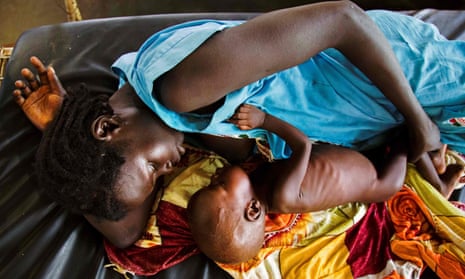Famine has been declared in parts of South Sudan, where UN agencies warned on Monday that war and a collapsing economy have left 100,000 people facing starvation.
A further 1 million people were classified as being on the brink of famine, according to the World Food Programme (WFP) and other UN bodies. Unimpeded humanitarian access was urgently needed to reverse “an escalating catastrophe”, they added.
The famine is the first to be declared since 2011 in Somalia, where more than a quarter of a million people are estimated to have died between October 2010 and April 2012.
The UN has warned that three other countries - Yemen, Somalia and Nigeria - are at risk of famine.
Famine has been declared in parts of Unity State in the northern-central part of South Sudan. The formal announcement means people have already started dying of hunger.
Three years of civil war has devastated hopes that the oil-rich country would prosper when it gained independence from Sudan at the end of one of Africa’s longest running conflicts. Unity State, which borders Sudan, has been at the centre of some of the fiercest fighting, while tens of thousands have been forced to flee their homes in the face of a government offensive against opposition-held areas.
The worsening crisis in South Sudan comes as three other countries - Yemen, Somalia and Nigeria - are at risk of looming famines, agencies have warned.
About 4.9 million people – more than 40% of South Sudan’s population – are in need of urgent food, agriculture and nutrition assistance, according to an Integrated Food Security Phase Classification (IPC) update released on Monday by the government, humanitarian organisations and the WFP, The Food and Agriculture Organisation (FAO) and the UN children’s fund, Unicef.
The IPC update, which was based on information built up over recent months, added that the total number of food insecure people is expected to rise to 5.5 million in July if nothing is done to curb the severity and spread of the food crisis.
Serge Tissot, FAO representative in South Sudan, said: “Famine has become a tragic reality in parts of South Sudan and our worst fears have been realised. Many families have exhausted every means they have to survive.
“The people are predominantly farmers and war has disrupted agriculture. They’ve lost their livestock, even their farming tools. For months there has been a total reliance on whatever plants they can find and fish they can catch.”
The IPC report, which assessed 23 of South Sudan’s 86 counties, estimates that 14 have global acute malnutrition (GAM), a measurement of the nutritional status of a population, at or above the emergency threshold of 15%. In some areas it was as high as 42%.
WFP country director Joyce Luma said: “This famine is man-made. WFP and the entire humanitarian community have been trying with all our might to avoid this catastrophe, mounting a humanitarian response of a scale that quite frankly would have seemed impossible three years ago.
“But we have also warned that there is only so much that humanitarian assistance can achieve in the absence of meaningful peace and security, both for relief workers and the crisis-affected people they serve.”
Food production in South Sudan was devastated by an upsurge in violence last year while soaring inflation – up to 800% year-on-year – and market failure have have left its people struggling to cope with massive price rises on basic food items.
Relief operations have been underway across South Sudan since the start of the conflict. The IPC assessment found that aid had lessened the risk of famine in other regions of the country, including Northern Bahr el Ghazal state.
The WFP said it plans to provide food and nutrition assistance to 4.1 million people during this year’s “hunger season” - when food from the last harvest has run out but new crops haven’t come in yet - including emergency food, cash and nutrition assistance.
Unicef, which said more than 1 million children are estimated to be acutely malnourished across South Sudan, plans to treat 207,000 children for severe malnutrition this year.
